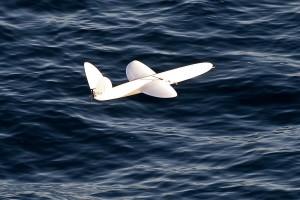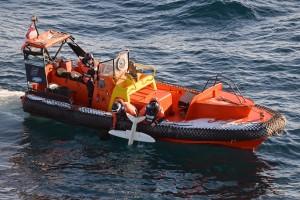 It’s finally here – the world’s first 3D printed airplane. Don’t go rushing off to book a flight, though, because the Southampton University Laser-Sintered Aircraft (SULSA) is only 3kg. It could perhaps carry a squirrel, but that’s about it. SULSA was designed for a much more critical purpose than chauffeuring rodents around the skies, however. Last week, the unmanned aerial vehicle (UAV) was tested by the British Royal Navy over the Antarctic, and the results were promising – in the future, the craft should be able to be used to help ships navigate through the ice-filled waters.
It’s finally here – the world’s first 3D printed airplane. Don’t go rushing off to book a flight, though, because the Southampton University Laser-Sintered Aircraft (SULSA) is only 3kg. It could perhaps carry a squirrel, but that’s about it. SULSA was designed for a much more critical purpose than chauffeuring rodents around the skies, however. Last week, the unmanned aerial vehicle (UAV) was tested by the British Royal Navy over the Antarctic, and the results were promising – in the future, the craft should be able to be used to help ships navigate through the ice-filled waters.
SULSA was tested for the first time last year off the coast of Dorset, England. Last week’s test flights were a lot more intensive. The tiny plane was launched from the Royal Navy’s ice patrol ship, the HMS Protector, several times for flights of about 30 minutes’ duration each. Operated via a laptop on board the ship, SULSA flew ahead of the Protector, sending back real-time footage of the sea and its ice to a monitor on board. After each flight, the plane dropped into the water where it was fished out by one of the Protector’s boats.
 It was the first time the Royal Navy had used UAVs in the Antarctic region.
It was the first time the Royal Navy had used UAVs in the Antarctic region.
“This trial of these low-cost but highly versatile aircraft has been an important first step in establishing the utility of unmanned aerial vehicles in this region,” said Captain Rory Bryan, the Protector’s Commanding Officer. “It’s demonstrated to me that this is a capability that I can use to great effect.”
SULSA is 3D printed in nylon using an EOS laser sintering printer in four large parts, which can be easily assembled without the use of any tools. The Royal Navy has been using ScanEagle “eyes in sky” drones as scouts in the Gulf for a few years, but SULSA offers several major advantages – there’s the ease of manufacture and assembly, plus the low cost. A SULSA aircraft costs about £7,000, which is chump change compared to other ship-launched drones. With a wingspan of 2 meters and a weight of 3 kg, it’s also easy to transport and store. SULSA has a nearly silent engine and a top speed of about 100 mph, and it’s capable of cruising at 60 mph.
“The series of flights conducted by Southampton staff in conjunction with the Royal Navy from HMS Protector has been a great success,” said Andy Keane, Professor of Computational Engineering at the University of Southampton. “These flights have shown just what can be achieved with smart design and low cost digital manufacture.”
While SULSA was controlled via laptop for these trials, it also has the capability to operate on autopilot. The Royal Navy also used a quadcopter to carry out short-range reconnaissance, while SULSA covered broader territory in its longer flights. The data gathered by the trial flights was sent back to the Navy’s headquarters. There’s still a lot of work to do, but SULSA’s performance in the first stages of testing shows that it has a lot of potential to guide ships through icy waters. If only the Titanic had been equipped with such technology.
“I am delighted with the successful deployment of small unmanned aerial vehicles from HMS Protector in the Antarctic,” said Commodore James Morley, the Navy’s Assistant Chief of Staff Maritime Capability. “The whole team has overcome significant hurdles to demonstrate the enormous utility of these aircraft for affordable and persistent surveillance and reconnaissance from ships – even in the environmentally challenging environment of the Antarctic.
“Although this was a relatively short duration trial to measure the relative merits of fixed and rotary wing embarked systems, we are continuing to review our options for acquisition of maritime unmanned aerial vehicles in the future.”
You can watch some of SULSA’s video footage below. What are your thoughts on this amazing new technology? Discuss in the SULSA 3D Printed Airplane forum over at 3DPB.com.
https://youtu.be/sGGN089Y-Js
[Source/Images: University of Southampton]
Subscribe to Our Email Newsletter
Stay up-to-date on all the latest news from the 3D printing industry and receive information and offers from third party vendors.
Print Services
Upload your 3D Models and get them printed quickly and efficiently.
You May Also Like
Reinventing Reindustrialization: Why NAVWAR Project Manager Spencer Koroly Invented a Made-in-America 3D Printer
It has become virtually impossible to regularly follow additive manufacturing (AM) industry news and not stumble across the term “defense industrial base” (DIB), a concept encompassing all the many diverse...
Inside The Barnes Global Advisors’ Vision for a Stronger AM Ecosystem
As additive manufacturing (AM) continues to revolutionize the industrial landscape, Pittsburgh-based consultancy The Barnes Global Advisors (TBGA) is helping shape what that future looks like. As the largest independent AM...
Ruggedized: How USMC Innovation Officer Matt Pine Navigates 3D Printing in the Military
Disclaimer: Matt Pine’s views are not the views of the Department of Defense nor the U.S. Marine Corps Throughout this decade thus far, the military’s adoption of additive manufacturing (AM)...
U.S. Congress Calls Out 3D Printing in Proposal for Commercial Reserve Manufacturing Network
Last week, the U.S. House of Representatives’ Appropriations Committee moved the FY 2026 defense bill forward to the House floor. Included in the legislation is a $131 million proposal for...



































